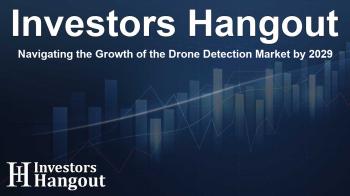Navigating the Growth of the Drone Detection Market by 2029

Understanding the Rise of the Drone Detection Market
As drone usage continues to proliferate across various sectors, the need for robust drone detection systems has become increasingly critical. The Drone Detection Market is projected to grow significantly, from USD 659.4 million in 2024 to an estimated USD 2,329.9 million by 2029. This rapid expansion is attributed to a compound annual growth rate (CAGR) of 28.7%, indicating a sea change in how security measures are being tailored to address modern threats.
Key Drivers of Drone Detection Market Growth
The growth of the drone detection market is primarily driven by a surge in unauthorized drone activities. These illicit operations raise critical security concerns, especially in areas such as military installations, critical infrastructure, and public spaces. It is essential for organizations to invest in detection technologies that can effectively identify and mitigate the risks posed by drones. Traditional security systems often struggle to detect unauthorized drones due to their small sizes, low flight altitudes, and high maneuverability, reinforcing the need for specialized detection solutions.
Impact of Security Concerns
In today's world, the potential risks associated with unauthorized drone usage include espionage and smuggling operations, making effective detection and neutralization essential for maintaining operational safety and national security. As a result, businesses and governments are increasingly turning to advanced technologies specifically designed to detect and manage drone threats.
Market Segmentation Analysis
The drone detection market can be dissected based on various factors, primarily application and type. In the military and defense sectors, the demand for drone detection systems is expected to dominate the market during the forecast period. This demand is largely driven by the perceived threats posed by unmanned aerial vehicles (UAVs) in both warfare and security scenarios.
Military Applications Lead the Charge
Globally, armed forces are prioritizing investments in drone detection technologies to protect strategic facilities such as military bases and airfields from UAV incursions. The use of drones in reconnaissance and electronic warfare has prompted a shift towards the development of advanced detection systems. Technologies including radar, radio frequency (RF) sensors, and electro-optical/infrared (EO/IR) systems are critical for ensuring comprehensive surveillance and rapid response capabilities.
Emerging Opportunities and Challenges
The handheld segment of the drone detection market is projected to grow at the highest rate during the forecasted period. Handheld devices provide essential portability, making them ideal for law enforcement and military personnel who need real-time detection capabilities across various locations. Security forces can operate these systems in tactical operations and high-risk environments without sacrificing mobility.
North America's Dominance in the Market
North America is set to take the lead in the drone detection market throughout the forecast period, driven by a combination of stringent regulations and heavy security investments in the region's defense infrastructure. Notable contractors and technology firms are continually working to innovate and implement cutting-edge drone detection systems to address increasing concerns over drone-related security incidents.
Future Outlook and Technological Advancements
As the drone detection landscape evolves, several market dynamics are presenting both opportunities and challenges. The drive for security, particularly in the U.S., is heightened by regulatory measures and a growing interest in artificial intelligence (AI) applications for drone detection.
Promising Developments Ahead
With the continuous advancement of detection technologies and strategic investments in defense and homeland security, the drone detection market is anticipated to flourish significantly in North America and beyond. Companies that leverage innovations in IoT and AI will find themselves well-positioned to capitalize on the growing need for effective drone detection solutions.
Frequently Asked Questions
What is the projected size of the Drone Detection Market by 2029?
The Drone Detection Market is expected to grow from USD 659.4 million in 2024 to USD 2,329.9 million by 2029.
What are the main drivers behind market growth?
The primary drivers include an increase in unauthorized drone activities and heightened security needs in military and critical infrastructure applications.
Which segment is anticipated to experience the highest growth?
The handheld segment of the drone detection market is projected to grow at the highest CAGR due to its portability and ease of use.
How does North America compare in the Drone Detection Market?
North America is expected to lead the market, supported by a strong defense infrastructure and substantial investments in drone detection systems.
What challenges does the market face?
Challenges include cybersecurity risks associated with connected detection systems and issues related to detection accuracy in crowded environments.
About The Author
Contact Olivia Taylor privately here. Or send an email with ATTN: Olivia Taylor as the subject to contact@investorshangout.com.
About Investors Hangout
Investors Hangout is a leading online stock forum for financial discussion and learning, offering a wide range of free tools and resources. It draws in traders of all levels, who exchange market knowledge, investigate trading tactics, and keep an eye on industry developments in real time. Featuring financial articles, stock message boards, quotes, charts, company profiles, and live news updates. Through cooperative learning and a wealth of informational resources, it helps users from novices creating their first portfolios to experts honing their techniques. Join Investors Hangout today: https://investorshangout.com/
The content of this article is based on factual, publicly available information and does not represent legal, financial, or investment advice. Investors Hangout does not offer financial advice, and the author is not a licensed financial advisor. Consult a qualified advisor before making any financial or investment decisions based on this article. This article should not be considered advice to purchase, sell, or hold any securities or other investments. If any of the material provided here is inaccurate, please contact us for corrections.

